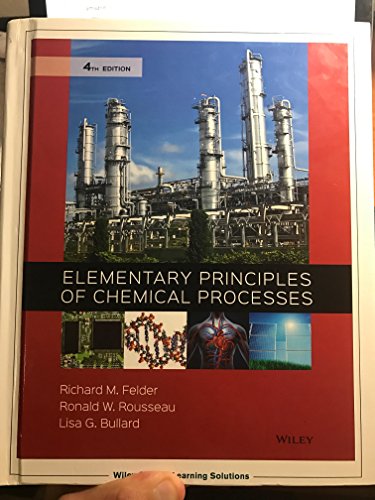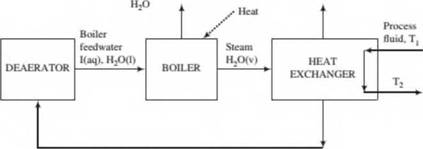
Boilers are used in most chemical plants to generate steam for various purposes, such as to preheat process streams fed to reactors and separation units. In one such process, steam and a cold process fluid are fed to a heat exchanger where enough energy is transferred from the steam to cause a large fraction of it to condense. The uncondensed steam is vented to the atmosphere, and the liquid condensate is recycled to a deaerator into which another liquid stream (makeup water) is fed. The makeup water contains some dissolved impurities and other chemicals that help prevent deposition of solids on boiler walls and heating elements, which would lead to a reduction in operating efficiency and eventually to safety hazards, possibly including explosions. The liquid leaving the deaerator is the feed to the boiler. In the boiler, most of the water in the feed evaporates to form steam, and some of the impurities in the feedwater precipitate to form solid particles suspended in the liquid (kept in suspension by the chemical additives in the makeup w ater). The liquid and suspended solids are drawn oft' as boiler blowdown, either in manual bursts or w ith a continuous blowdown system.
A diagram of the system is shown below. The symbol I is used for combined impurities and chemical additives. The makeup water contains 1.0 kg 1/2.0 X 103 kg HjO, and the ratio in the blowdown is 1.0 kg 1/3.5 X 102 kg HiO. Of the steam fed to the heat exchanger, 76% is condensed.

- In your own words, describe why makeup water, chemical additives to the makeup water, and blowdown are necessary in this process. Speculate on the probable disadvantage of making the 1/HsO ratio in the blowdown (I) too small, and (ii) too large.
- Assume a basis of calculation and draw and fully label a flow chart of the process. (When you draw the heat exchanger you can omit the process fluid, which plays no role in the problem.)
- Carry out a degree-of-freedom analysis and outline a solution procedure (which equations would you write in which order to calculate all of the unknow ns on the chart?).
(d, Calculate the ratio (mass of makeup water/lOOkg steam produced in boiler) and the percentage of the boiler feedwater taken off as blowdown.
(c) A proposal has been made to use highly purified water as makeup. List the benefits that would result from doing so and the most likely reason for not doing it.
Want to see the full answer?
Check out a sample textbook solution
Chapter 4 Solutions
Elementary Principles Of Chemical Processes
Additional Engineering Textbook Solutions
Starting Out with Python (4th Edition)
Concepts Of Programming Languages
Java How to Program, Early Objects (11th Edition) (Deitel: How to Program)
Management Information Systems: Managing The Digital Firm (16th Edition)
INTERNATIONAL EDITION---Engineering Mechanics: Statics, 14th edition (SI unit)
Modern Database Management
- Show that the overall mass transfer coefficient, Ky, can be related to the individual gas and liquid film mass transfer coefficients, ky and kx, respectively, by the following equation: 1 K y = 1 + m kk y xarrow_forwardUse the approach given to solvearrow_forwardAntoine constants for vapor pressure for n-pentane and n-hexane are listed in Table 2-3. a. Predict the vapor pressure at 0.0°C for pure n-pentane. b. Predict the boiling point of pure n-pentane at 3.0 atm pressure. c. Predict the boiling pressure if pure n-pentane is boiling at 0.0°C. d. At a pressure of 500.0 mm Hg and temperature of 30.0°C, predict the K values for n-pentane and n-hexane using Raoult’s law. e. If T = 30.0°C and p = 500.0 mm Hg, determine the mole fractions in the liquid and vapor phases of an equilibrium mixture of n-pentane and n-hexane. f. 1.0 moles of a mixture that is 75.0 mol% n-pentane and 25.0 mol% n-hexane is placed in a closed chamber. The pressure is adjusted to 500.0 mm Hg, and the temperature to 30.0°C. The vapor and liquid mole fractions were found in part e. How many moles of liquid and moles of vapor are there at equilibrium? g. If 1.0 mol/min of a mixture that is 75.0 mol% n-pentane and 25.0 mol% n-hexane is fed continuously to an equilibrium flash…arrow_forward
- A 40 mol % ethanol 60 mol % water mixture at 60 °C and 1 atm is heated. Using Figure 2-3 answer the following:a. At what temperature does the mixture first begin to boil? What is the composition of the first bubble of vapor?b. At what temperature would it stop boiling (assume no material is removed)? What is the composition of the last droplet of liquid?c. At 82 °C, what fraction is liquid? d. When 90% has been vaporized, what is the temperature, and what are the liquid and vapor compositions?arrow_forwardIs a component with a lower vapor pressure more or less volatile than a component with a higher vapor pressure? Briefly explain.arrow_forward3.3. Use the following crude assay data with crude API of 36 to estimate cut vol%, critical properties and molecular weight for Light Naphtha (90- 190 °F) and Kerosene (380-520 °F). In addition, calculate the fractions of paraffins, naphthenes and aromatics in the two cuts. ASTM D86 (°F) Volume % Cum vol% SG 86 0.0 0.0 122 0.5 0.5 0.6700 167 1.2 1.7 0.6750 212 1.6 3.3 0.7220 257 2.7 6.0 0.7480 302 3.1 9.1 0.7650 347 3.9 13.0 0.7780 392 4.7 17.7 0.7890 437 5.7 23.4 0.8010 482 8.0 31.4 0.8140 527 10.7 42.1 0.8250 584 5.0 47.1 0.8450 636 10.0 57.1 0.8540 689 7.8 64.9 0.8630 742 7.0 71.9 0.8640 794 6.5 78.4 0.8890 20 8 002 09310 Iarrow_forward
- Problem 1) A fractional factorial design has been used to study on the effect of 3 parameters including adsorbent concentration (300 and 500 ppm), pH value (4 and 10) and reaction time (6 and 12 hours) on the adsorption capacity of a composite for removing of methylene blue from a wastewater. If the results obtained for two repetitions of the tests are according to the following table, it is desirable: A) Design Resolution Y₁ Y₂ Run (mg/g) (mg/g) B) Drawing graphs of the effect of each parameter on the adsorption capacity 1 28 26 2 36 34 C) Analysis of interactions 3 18 20 D) Calculate the effects percentage of each parameter and error 4 32 30 E) Determining the optimum conditions to achieve the highest adsorption capacityarrow_forwardThermophysical Properties of Petroleum Fractions and Crude Ofls 67 3.4. A gas oil has the following TBP distillation data Volume % TBP (°C) 0 216 10 243 30 268 50 284 70 304 90 318 95 327 100 334 It also has an average boiling point of 280 °C and an average density of 0.850 g/cm³. (a) Split this gas oil fraction into five pseudo-components. Calculate T., Pc and w for each pseudo-component. (b) Calculate T, Pc and w for the whole gas oil fraction. (c) Calculate the enthalpy of this gas oil fraction at 400 °C using the Lee- Kessler correlation with a reference state of ideal gas at 273.15 K.arrow_forward3.3. Use the following crude assay data with crude API of 36 to estimate cut vol%, critical properties and molecular weight for Light Naphtha (90- 190 °F) and Kerosene (380-520 °F). In addition, calculate the fractions of paraffins, naphthenes and aromatics in the two cuts. ASTM D86 (°F) Volume % Cum vol% SG 86 0.0 0.0 122 0.5 0.5 0.6700 167 1.2 1.7 0.6750 212 1.6 3.3 0.7220 257 2.7 6.0 0.7480 302 3.1 9.1 0.7650 347 3.9 13.0 0.7780 392 4.7 17.7 0.7890 437 5.7 23.4 0.8010 482 8.0 31.4 0.8140 527 10.7 42.1 0.8250 584 5.0 47.1 0.8450 636 10.0 57.1 0.8540 689 7.8 64.9 0.8630 742 7.0 71.9 0.8640 794 6.5 78.4 0.8890 20.8 99.2 0.9310arrow_forward
- ۱۱۳ ۱۱۱۰ ۱۱۰ A + C Chegg Learn on the go = Chegg © chegg.com/homewo Open in app EN-US QUESTIONS AND PROBLEMS 4.1. With 100,000 BPD of the following crude (API = 36), estimate the products of the atmospheric distillation column. If the atmospheric residue of the crude is taken at 650+ F. It enters in a vacuum distilla- tion tower to give three products: light vacuum gas oil (650-850 °F), heavy vacuum gas oil (850-1050 °F) and vacuum residue (1050+ °F). Calculate the mass flow rate of these products. Then calculate the sulphur content (lb/hr) for each product. ASTM D86 (°F) vol% Cum vol% SG 86 0.0 0.0 122 0.5 0.5 0.6700 167 1.2 1.7 0.6750 212 1.6 3.3 0.7220 257 2.7 6.0 0.7480 3021 3.1 9.1 0.7650 347 3.9 13.0 0.7780 392 4.7 17.7 0.7890 437 5.7 23.4 0.8010 4821 8.0 31.41 0.8140 527 10,7 42.1 0.8250 584 5.0 47.1 0.8450 6361 10,0 57.1 0.8540 689 7,8 64.9 0.8630 7421 7.0 71.9 0.8640 794 6.5 78.4 0.8890 20.8 99.2 0.9310 Show transcribed image text Here's the best way to solve it. This problem…arrow_forwardQ1/obtain the transfer function for the block diagram shown in the figure below: G4 Garrow_forward(Population density parameters from sieve analysis data)2 One hundred fifty grams of crystals separated from one litre of suspension from an MSMPR crystallizer is subjected to screen analysis to get the following data: Tyler mesh Mass(g) 12/14 28.5 14/20 29.2 20/28 28/35 35/48 below 48 mesh 37.5 27 24.7 3.1 Mesh no./ screen opening(um) data: 12/1410 μm; 14/1190; 20/841; 28/595; 35/420; 48/297. The working volume of the crystallizer is 200 litres, and the rate of withdrawal of the slurry is 250 litre per hour. Given pc = 1400 kg/m³ and volume shape factor o, = 0.42, determine the crystal growth rate and the zero-size population density of the crystals. What is the rate of nucleation, Bº?arrow_forward
 Introduction to Chemical Engineering Thermodynami...Chemical EngineeringISBN:9781259696527Author:J.M. Smith Termodinamica en ingenieria quimica, Hendrick C Van Ness, Michael Abbott, Mark SwihartPublisher:McGraw-Hill Education
Introduction to Chemical Engineering Thermodynami...Chemical EngineeringISBN:9781259696527Author:J.M. Smith Termodinamica en ingenieria quimica, Hendrick C Van Ness, Michael Abbott, Mark SwihartPublisher:McGraw-Hill Education Elementary Principles of Chemical Processes, Bind...Chemical EngineeringISBN:9781118431221Author:Richard M. Felder, Ronald W. Rousseau, Lisa G. BullardPublisher:WILEY
Elementary Principles of Chemical Processes, Bind...Chemical EngineeringISBN:9781118431221Author:Richard M. Felder, Ronald W. Rousseau, Lisa G. BullardPublisher:WILEY Elements of Chemical Reaction Engineering (5th Ed...Chemical EngineeringISBN:9780133887518Author:H. Scott FoglerPublisher:Prentice Hall
Elements of Chemical Reaction Engineering (5th Ed...Chemical EngineeringISBN:9780133887518Author:H. Scott FoglerPublisher:Prentice Hall
 Industrial Plastics: Theory and ApplicationsChemical EngineeringISBN:9781285061238Author:Lokensgard, ErikPublisher:Delmar Cengage Learning
Industrial Plastics: Theory and ApplicationsChemical EngineeringISBN:9781285061238Author:Lokensgard, ErikPublisher:Delmar Cengage Learning Unit Operations of Chemical EngineeringChemical EngineeringISBN:9780072848236Author:Warren McCabe, Julian C. Smith, Peter HarriottPublisher:McGraw-Hill Companies, The
Unit Operations of Chemical EngineeringChemical EngineeringISBN:9780072848236Author:Warren McCabe, Julian C. Smith, Peter HarriottPublisher:McGraw-Hill Companies, The





